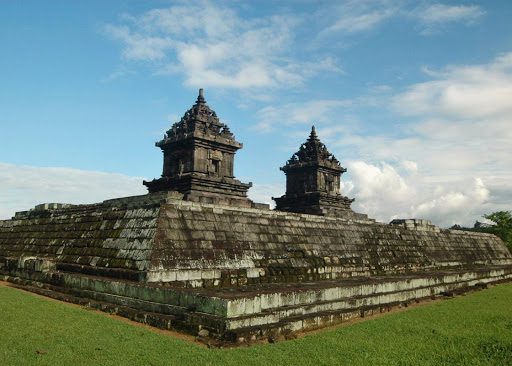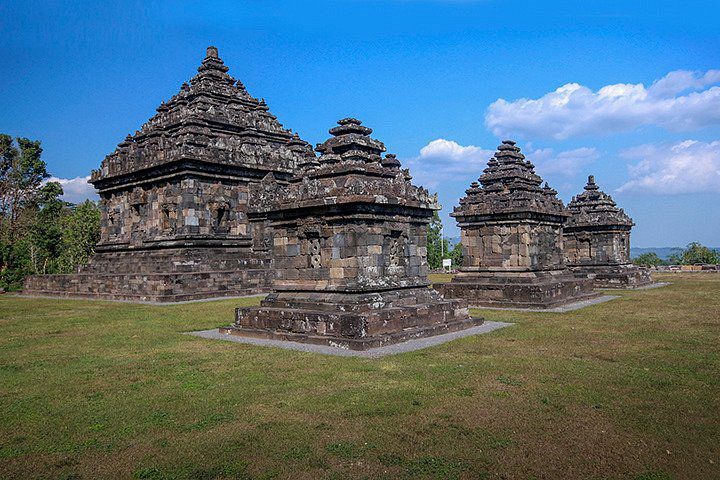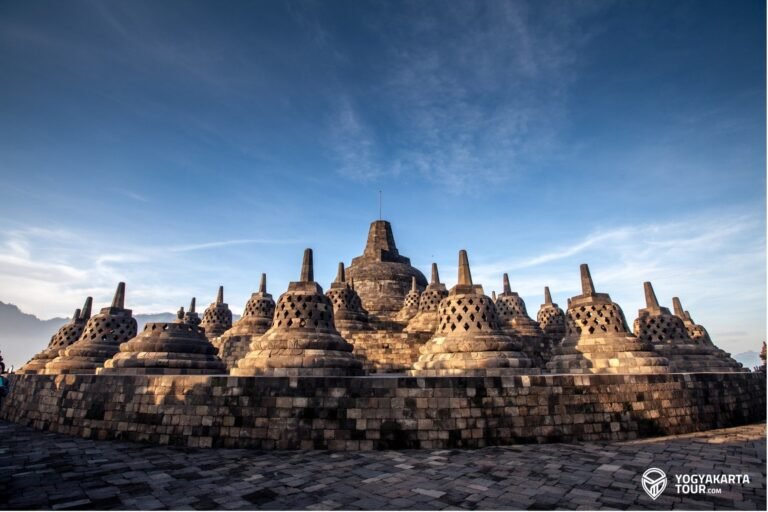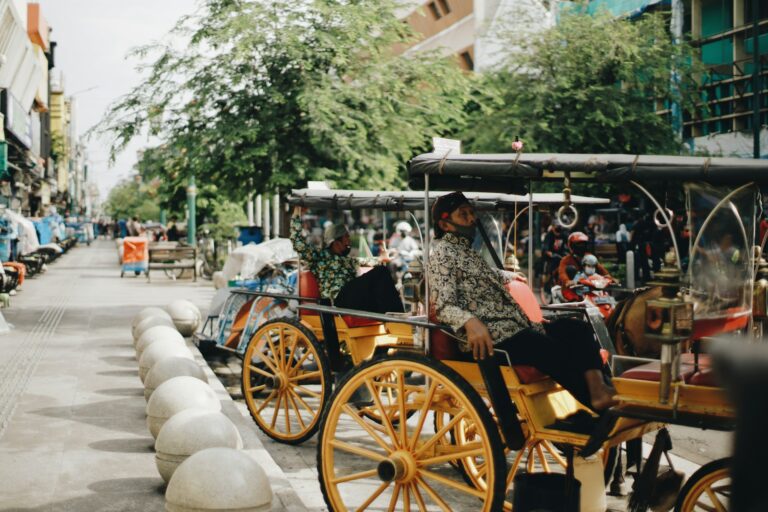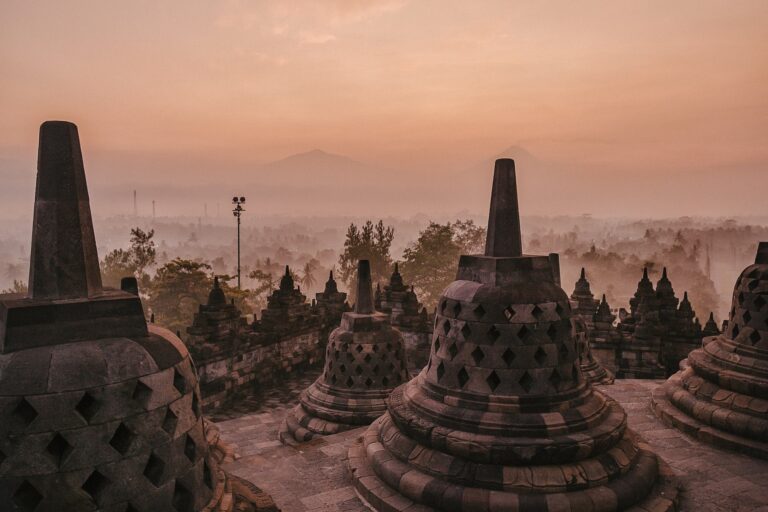Barong Temple is one of the Hindu temples from the Ratu Boko complex. So, it’s close to other remnants of the ancient Mataram Kingdom, like Banyunibo Temple and Ijo Temple.
You can find Barong Temple in Candisari Hamlet, Sambirejo Village, Prambanan Subdistrict, Sleman Regency, Yogyakarta.
According to inscriptions in the vicinity, it’s estimated that a ruler from the ancient Mataram Kingdom founded Barong Temple in the 9th century.
Background
Barong Temple is one of those Hindu-style temples situated southeast of the Ratu Boko Complex in Prambanan, Sleman. It sits on a hill in Candisari Hamlet, Sambirejo Village, Prambanan, Sleman Regency, Yogyakarta.
The name ‘Barong’ is derived from the main temple’s adornments featuring Kala and Makara in each niche, similar to the iconic Barong figure in Javanese culture.
The temple complex has its entrance on the west side, leading to a tiered terrain. The first and second terraces no longer have temple structures; remnants of floors or pedestals are still visible.
The second terrace is a quite spacious open area. Before reaching the highest terrace, there’s a small paduraksa gate flanking the ascending stairs.
On the highest terrace, you’ll find two temple structures for worship, believed to be dedicated to Lord Vishnu and Goddess Sri. Each of these main temples has dimensions of approximately 8.18 m × 8.18 m with a height of 9.05 m. These main temple structures lack entrances, suggesting that worship ceremonies likely occurred outside the buildings.
The unique feature of this temple complex is the worship of Vishnu. Typically, Central Javanese temples venerate Lord Shiva or have a Shivaistic nature.
Moreover, the tiered structure with the main worship area located at the easternmost part is unusual for temples from the Medang period, where the main structures are usually at the center of the complex.
Only Ijo Temple shares a similar characteristic. This tiered structure is considered an authentic expression of Indonesia. The syncretic nature is also evident in the worship of Goddess Sri.
Read More: Ratu Boko: Grandeur on a Hill Full of Tranquility That Mesmerizes
History
Barong Temple was built around the 9th and 10th centuries AD as a relic from the Medang Kingdom during the Mataram period.
It was rediscovered in the early 20th century in a crumbled state when a Dutch person expanded a sugar factory’s sugarcane plantation.
The locals named it “Barong” because the kala ornaments in the temple’s niches resemble the Barongan, a mystical creature in Javanese mythology.
Barong Temple also goes by another name, Candi Sari Suragedug, inscribed in the Sanskrit language on the Ratu Baka Inscription.
According to this inscription, King Sri Kumbaja (Mpu Kumbhayoni) built three lingas named Krttiwasalingga, Triyarbakalingga, and Haralingga.
These lingas, accompanied by Goddess Sri, Goddess Suralaksmi, and Goddess Mahalaksmi, are likely referring to Barong Temple.
The Pereng Inscription dated 863 AD mentions that Rakai Walaing Mpu Kumbhayoni granted fields and two hills in Tamwahurang in the year 784 Saka or 860 AD.
These were given for the maintenance of the Shiva temple named Bhadraloka. According to experts, this structure likely refers to Barong Temple.
What Makes It Unique?
As we already know, Sambisari Temple has a design that is almost similar to that of Plaosan Temple. In contrast, Barong Temple is known for its unique design, which is not found elsewhere.
Unlike typical temples, Barong Temple doesn’t have chambers. Instead, you’ll find niches used for storing statues.
However, the statues, lingga, and yoni are not found here. Even statues of Lord Vishnu and Goddess Sri are absent from the temple. The temple is surrounded by the activities of farmers in the fields, farms, and small plantations.
This confirms that the temple was used as a place of worship for Lord Vishnu and Goddess Sri.
Nestled in the Hilly Area
Barong Temple sits in the hills of Batur Agung, creating a cool and breezy ambiance in the temple area.
Winged Shell Decorations
The winged shell decorations, also known as Sankha, make this temple unique. These ornaments symbolize Lord Vishnu. The pinnacle of the building is shaped like a gem, referred to as Ratna.
Sunset Spot
For a visit to this temple, it’s best to come in the afternoon. From Barong Temple, you can enjoy a beautiful sunset view.
Operational Hours and Entrance Fee
This temple is open every day from 06:00 to 17:00 WIB. To visit the museum, you just need to pay Rp. 5,000. But if you bring a vehicle, there’s a parking fee: Rp. 2,000 for motorcycles and Rp. 5,000 for cars.
Location and Routes
Barong Temple is located in Candisari, Sambirejo Village, Prambanan, Dowang Sari, Sambirejo, Prambanan, Sleman Regency, Special Region of Yogyakarta. Getting to the temple is quite easy, and the road suits vehicles.
The route is straightforward: from Jl Raya Solo – Yogyakarta, just drive east along the main road until you reach the Prambanan Terminal intersection. At the intersection, turn right onto Jl Raya Piyungan – Prambanan.
Follow the main road to reach Bokoharjo Square, then turn right and follow the main road to arrive at the Barong Temple area.
Read More: Ijo Temple: The Unique Highest Temple in Yogyakarta
Historical Tourism
Barong Temple is a go-to spot for history enthusiasts. This Hindu heritage holds its unique charm, setting it apart from other temples. The special touch comes from the captivating Barong ornament that decorates the entire structure.
Even though reaching the temple complex might be a bit challenging, it doesn’t dampen the excitement of travelers eager to soak in the beauty of this place. If you’re a culture buff, this spot is worth considering for your next travel destination.
Photography Tourism
Aside from cultural exploration, you can also take a photo hunt at this tourist spot. The temple boasts beauty in its architectural design. Different from other temples, the unique ornaments make for beautiful subjects in your photos.
Moreover, you can have a blast taking selfies or posing against the backdrop of this historically significant temple.
If you visit the temple in the late afternoon, you’ll be treated to the breathtaking sunset view from the temple’s surroundings.
Capture photos with the temple as your backdrop, capturing the temple’s beauty and the sunset if you visit during that time.
Let’s Explore Yogyakarta!
Embark on an unforgettable journey to Java, Indonesia, where a world of wonders awaits! Java, the heart and soul of Indonesia, is a treasure trove of diverse landscapes, rich cultural heritage, and breathtaking experiences.
Find out the package now from Yogyakarta Tours:
- 1 Day Tours:
Prambanan Ramayana Ballet tour
- Multiday Tours
Author: Pramitha Chandra

